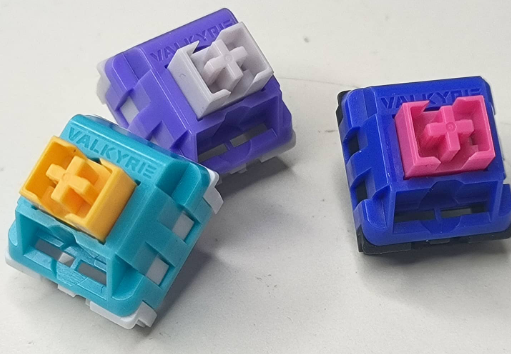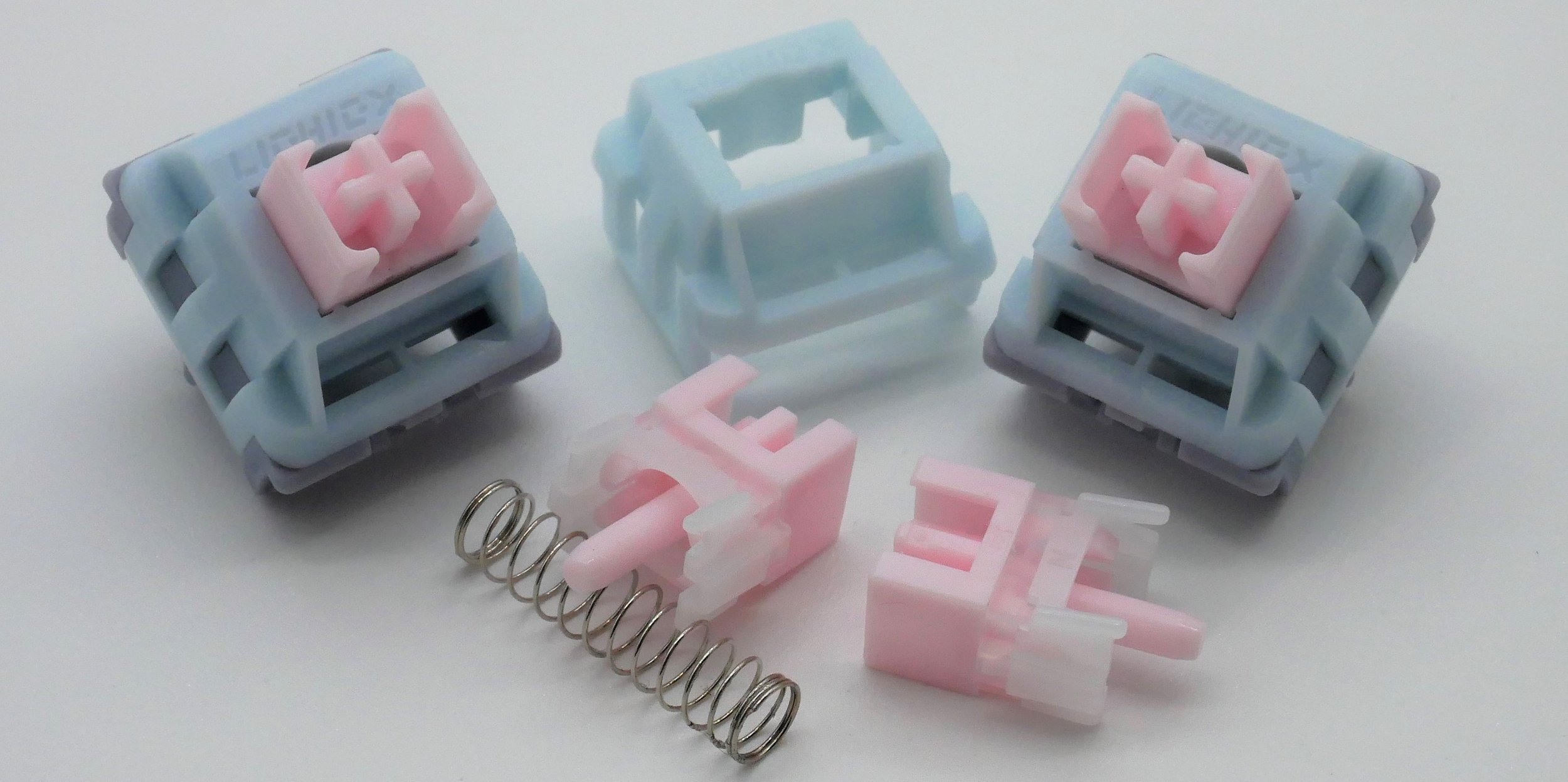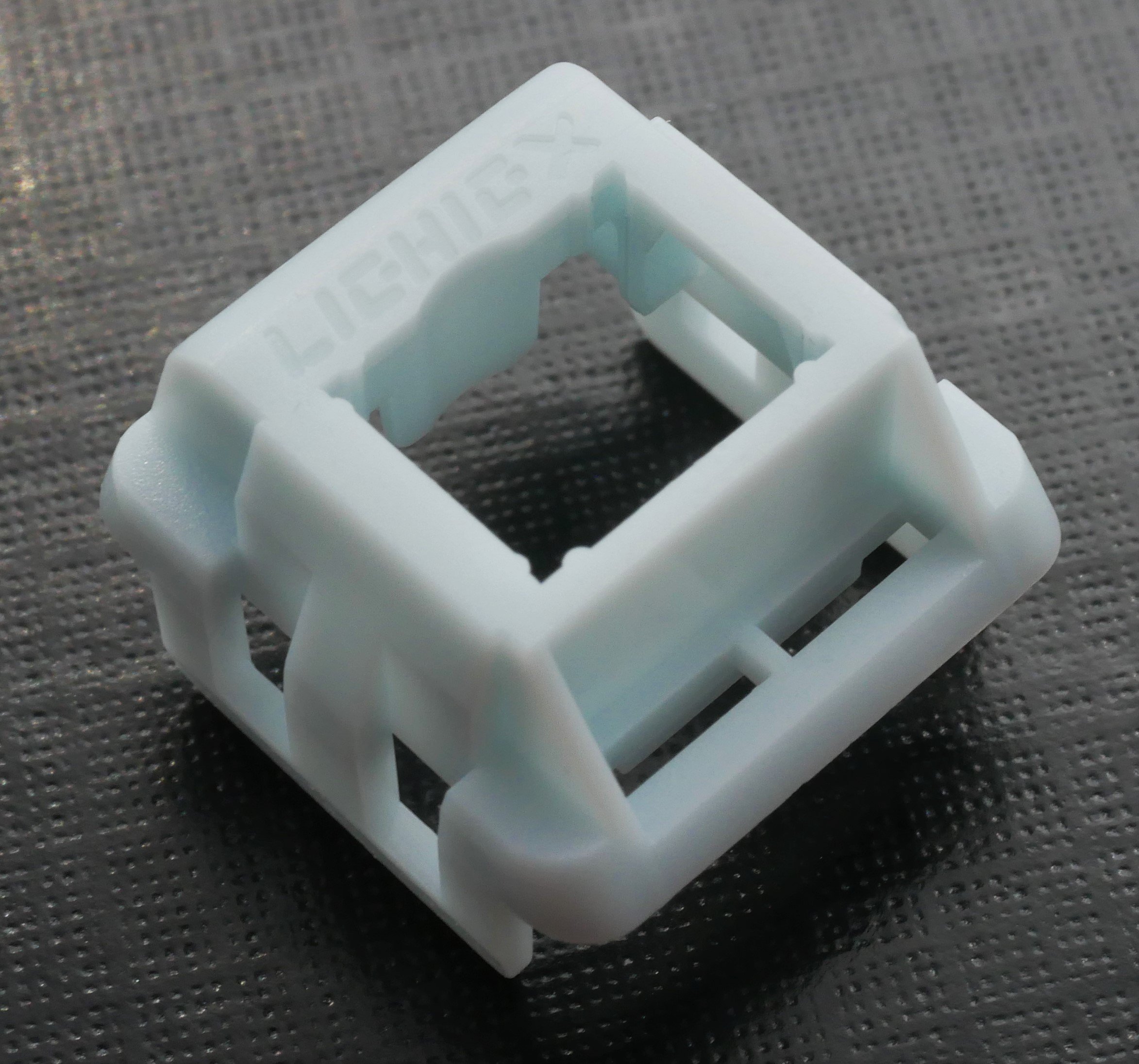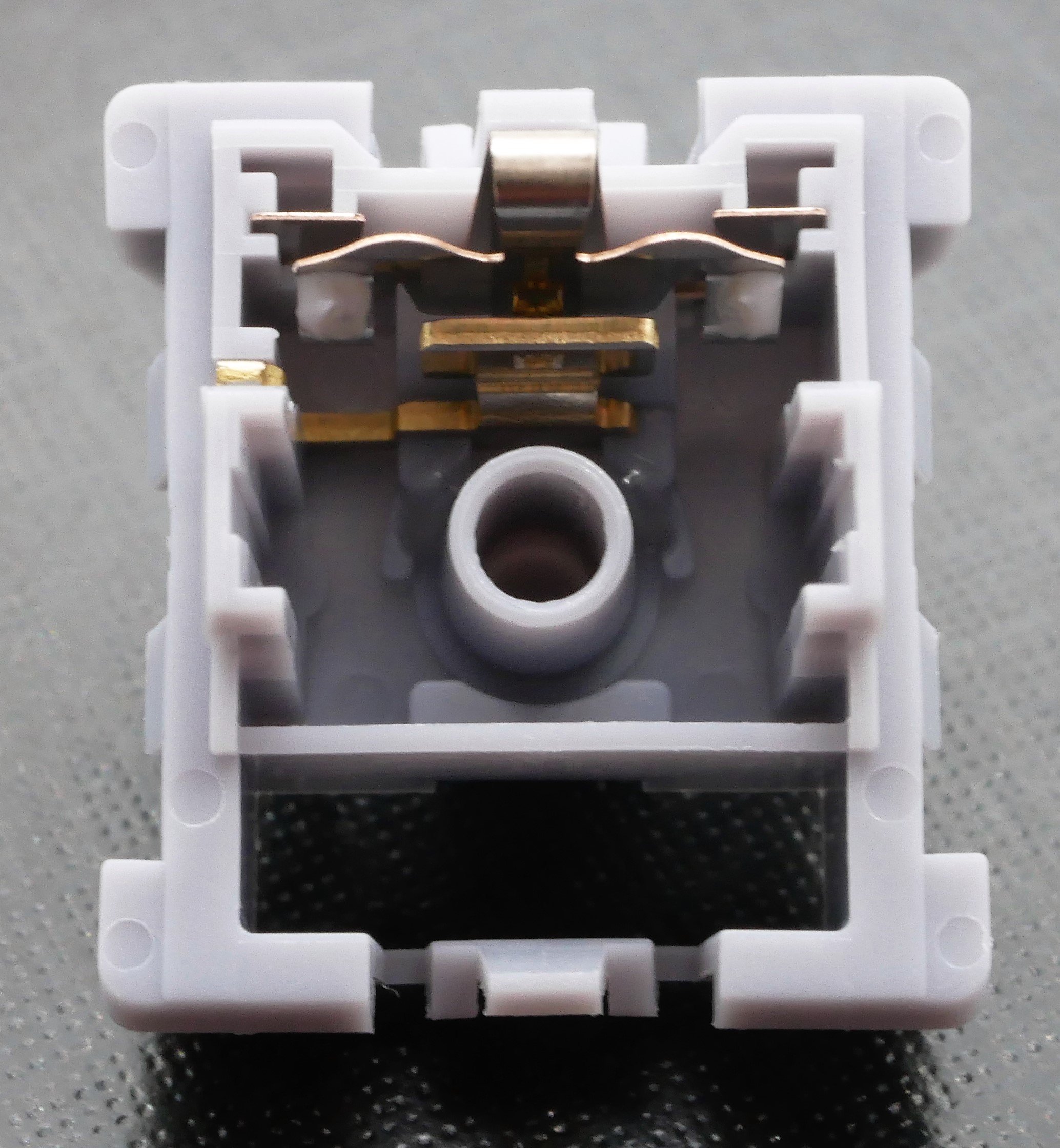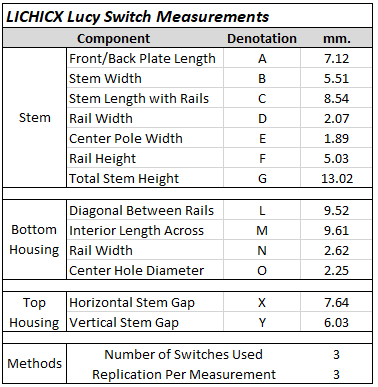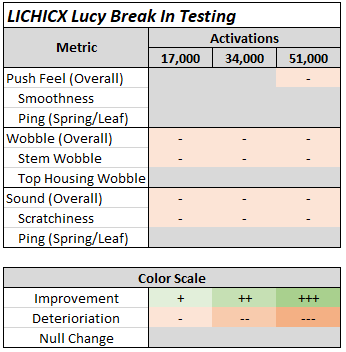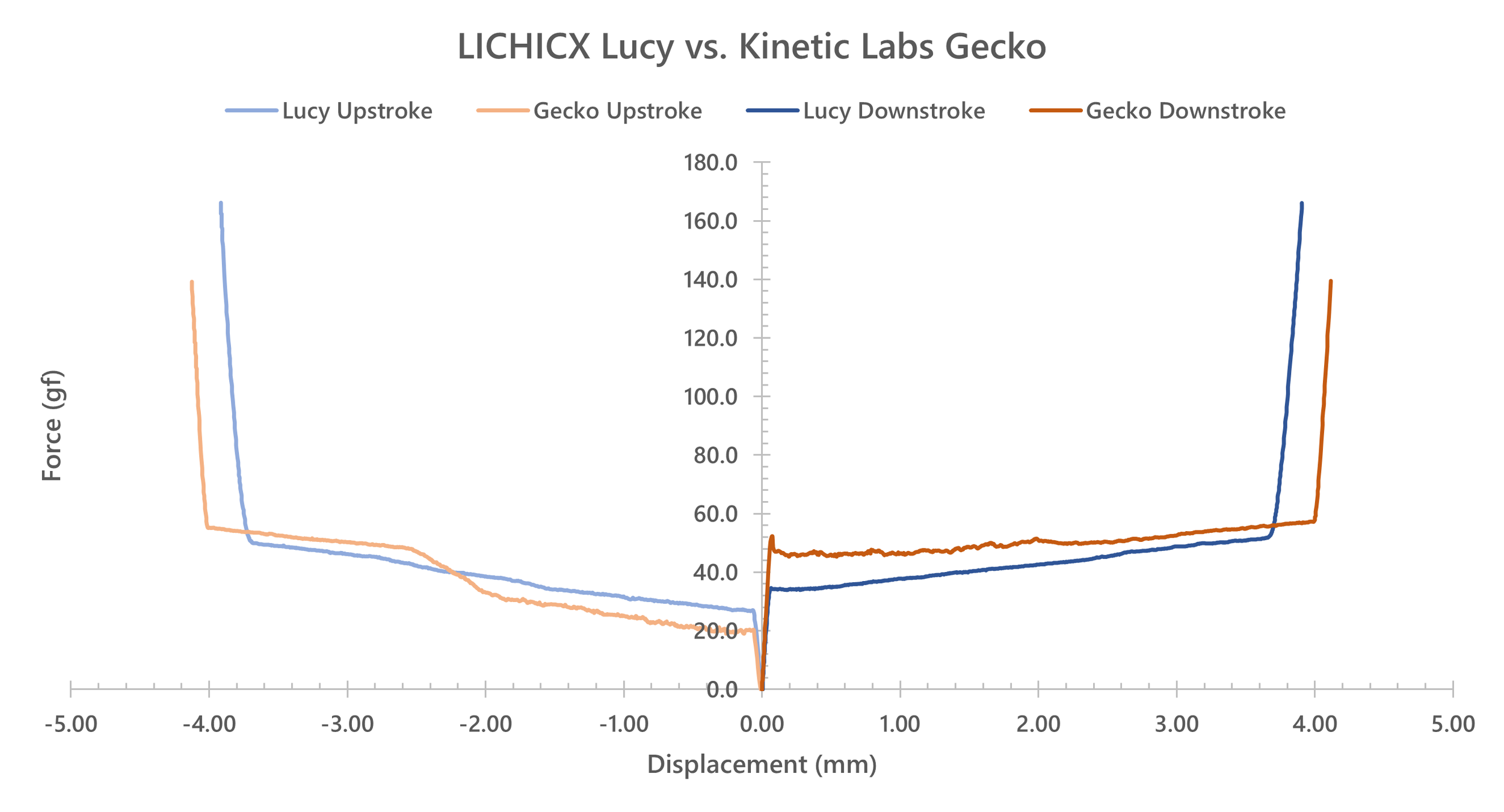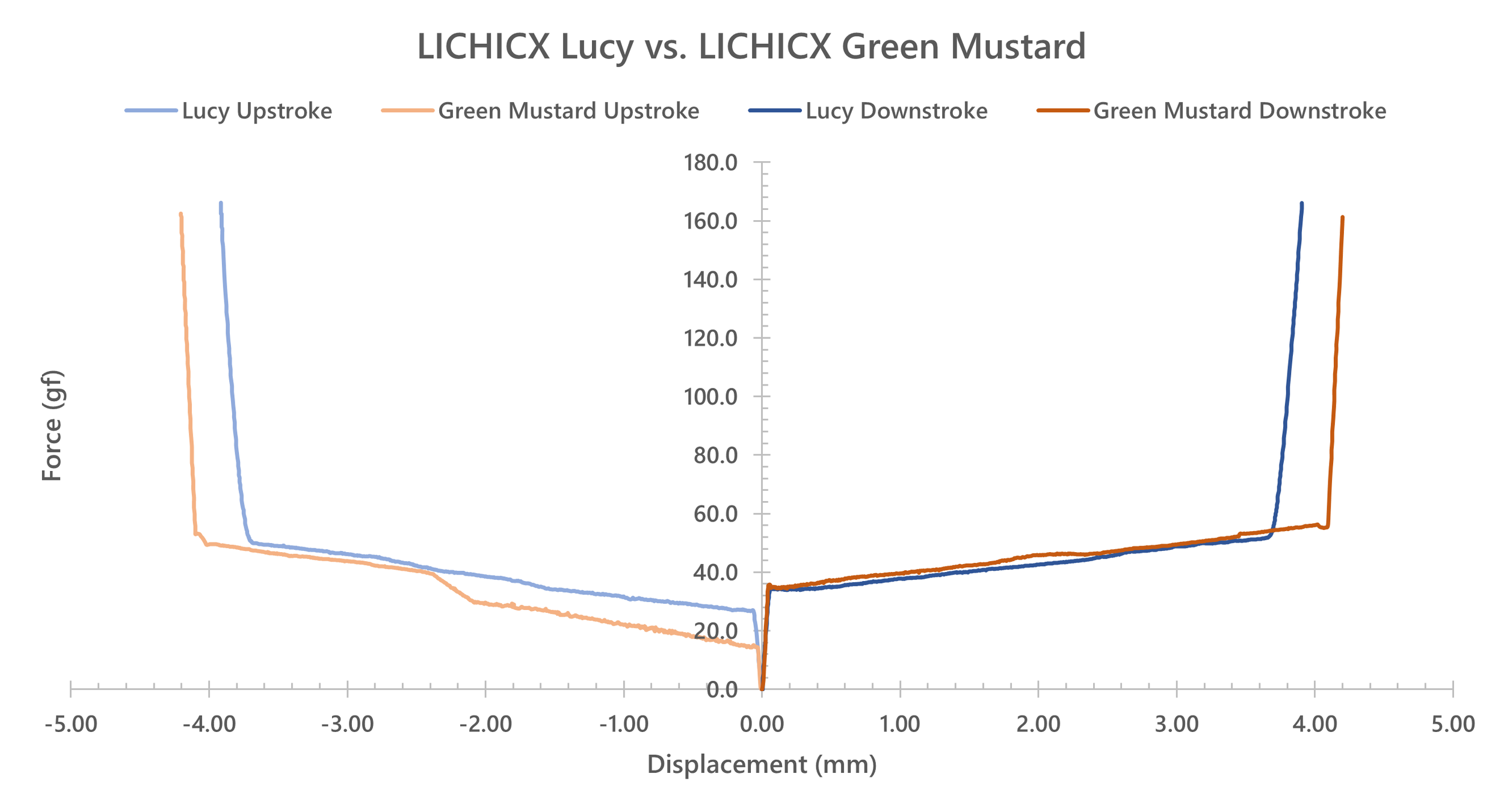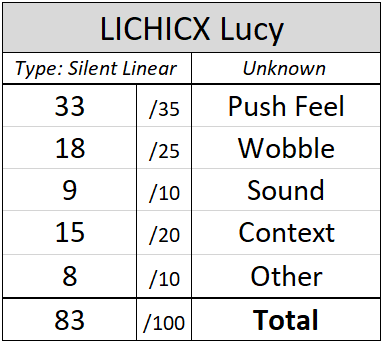LICHICX Lucy Switch Review
Man, big boy jobs in the real world are quite a bit more stressful than I would have initially anticipated a few months back. Most week thus far have been pretty smooth sailing, but this past week or two of work has felt more like two or three with all of the impending crises piling up. As a result, I can’t say I’ve done all that much in my free time or really have all that much in the way of personally exciting news to share like I traditionally do at the start of my reviews. The only particularly interesting point of my life in the past few weeks that is worth sharing is my purchase of yet another writing keyboard to be ground into dust with week-on-week switch review abuse. Purchased on mechmarket for a fairly good price, I’m now excited to be adding a Black, F13 Geonworks Frog with NOS Vintage Blacks into the mix of writing keyboards which rotate in and out depending on the mood at hand. Knowing full well that people would be interested in seeing what it looks like from my desk, the following are my post writing session photos I want to share of it dressed up in GMK Yugo, a keycap set I’ve had sitting in a box way too long for how pretty it is in person.
Figure 1: Might have went a touch hard on the color saturation, but the creamy yellow color is really hard to nail in photos.
Figure 2: Of course had to show off my favorite funny keys as well.
Switch Background
It’s not every week that I get to sit down and write a switch review for a switch from a brand as budding as ‘LICHICX’. While more regular readers may have recognized this name readily after having seen my Odd Switch Short on HAPE Oranges, I’ll be the first to admit that my awareness of this brand has grown significantly since I wrote that short article a few weeks ago. Since that article, not only have I been made aware of several more LICHICX branded switches out there, but I’ve also been made aware of other non-Varmilo branded collaborations they (may) have made, their continuations of the LICHICX branded switches, and even some of their Chinese patents which can be found under the name of their parent company. While this would previously have been more than enough for me to declare this another separate factory to add to the growing list of manufacturers by the month, a lack of clarity that’s been created around all brands as a result of the explosion in offerings in the past few years makes previously concrete evidence seem much more porous to me. Take something like Momoka, for example. I went ahead and readily chose to refer to them as their own production house based on claims with an employee from there, and yet they’ve somehow only made four switches since their debut – none of which have been in 2023 at all. So long as LICHICX continues to produce switches in the coming months, I will likely amend my decision here in this article to add this to the list of known production houses.
Figure 3: To be entirely honest, this list feels incredibly long already to a switch boomer like me.
Documentarian rant aside, those of you who are not already aware of LICHICX haven’t exactly been living under a rock nor missing some grand important news somewhere. First making their appearance in the west in late November of 2022 by way of the HAPE Orange switches, LICHICX has been a fairly slow rolling manufacturer until the last few months when production has exploded and/or we’ve become much more aware of their previously eastern-only releases. Up until February or March of 2023, HAPE Orange and LICHICX Green Mustards were the only two switches baring this branding to the best of my knowledge, and they seemingly appeared to be another OEM-style brand that would fade into the background in coming months. However similarities noted by other switch collectors between the mold markings in the HAPE Oranges, Green Mustards, and Varmilo’s EC V2 switches among all things seemingly established a connection between this new brand and a much more older, established line of switches. Further making this discovery interesting is that the Varmilo EC switches, both V1 and V2, never had an established manufacturer associated with them positively, with only vague speculation filling the void for years until these mold marking similarities were discovered. As well, if these details in and of themselves weren’t compelling enough, documentation and other websites also discovered by various collectors further strengthens this connection.
In addition to discovering a series of articles and Chinese videos and articles on fora such as Zhihu and Bilibili which show other previously unknown LICHICX switches, one particular individual was able to discover a facility name under which several Chinese patents have been published for keyboard switches and related designs. Filed under the name ‘Shenzhen Lichi Innovation Technology Co. LTD’, which has a striking similarity to the LICHICX brand name, the most immediately striking patents are for “Static capacitive mechanical keyswitch” (CN207074995U) and “Capacitance key switchs” (CN207339812U). As the name may imply, these are technologies which both are directly present in Varmilo’s Electrocapacitive (EC) line of switches and thus seemingly solidifies the connections noted between mold markings and designs of LICHICX branded and Varmilo branded switches. While further sub brands of the Shenzhen Lichi Innovation Technology Co. LTD factory have yet to be as firmly established, it is also believed that they may be producing switches in an OEM-partnership under the branding and/or nameplate ‘VALKYRIE’, which have been shown on Instagram by a Chinese switch collector by the name of xcjzzzzz.
Figure 4: Image from CN21357482U by Shenzhen Lichi Innovation Tech. Co LTD.
Figure 5: Instagram photo of Valkyrie switches by chinese switch collector xcjzzzzz.
In addition to these connections being drawn over the span of the past few months, a couple more LICHICX made switches have been released to western audiences which have helped drive attention towards the brand as well. The first, which was only picked up by me a handful of weeks ago, is that of the ‘Old DG Silver’ branded switch featuring a purple stem in a grey housing fixed with an LED condenser on the front. The second, slightly more well known LICHICX made switch is believed to be that of the Wikuo Harmony switches. Shared by me in an Instagram and Twitter mailday post on April 28th of 2023, these switches which were gifted to me by (my new wonderful sponsor) Keebut appear to line up with mold markings of LICHICX Green Mustard and HAPE Orange switches, driving a similar assumption of connectivity to the brand as the Varmilo EC switches have previously. While other LICHICX branded and made switches are continuing to be discovered seemingly by the week, the most recent and readily accessible switch from this brand in the west is that of the Lucy switches which I am reviewing here.
Figure 6: Trio of western available LICHICX switches including Old DG Silver, Lucy, and Wikuo Harmony from left to right.
First beginning to be stocked by vendors such as SwitchOddities, Chosfox, and MKZealots in late April of 2023, these silent linear LICHICX branded switches have stirred up quite a bit of excitement among switch collectors to date. Featuring the same silencing technology in the stems that drove me to write the short article on the HAPE Orange switches, these silent linear switches come with a ‘POK’ top housing, custom silicone stem silencer, and a nylon mixed bottom housing – none of which seem to be common in the slightest among all the various switches released as of late. Coming with a fairly normal travel distance and slightly lighter spring bottoming out weight, the LICHICX Lucy switches, which are also sometimes branded as ‘XCJZ Lucy’ switches, have been being sold at approximately $0.60 per switch. While the general plans for their continuation into the future are highly uncertain, and doubly so given the fact that the HAPE Orange switches were only supposedly produced out to 10,000 switches prior to their discontinuation, I imagine the broad community interest in them at such an early stage will see their success and potential successor launch soon after their final production run.
Lucy Switch Performance
Appearance
At the highest level, the LICHICX Lucy switches come in a three-part colorway with pastel pink dustproof stem, blue winglatch top housing, and purple 5-pin bottom housing. Not knowing if ‘Lucy’ is supposed to be referring to some form of anime character or not, I am under the assumption that this is somehow a weeb-related colorway decision (unfortunately). The switches have several LICHICX-specific features which help distinguish them from other switch brands currently, but the two most readily noticeable features include the ‘LICHICX’ nameplate as well as the ever so slightly rounded interior corners of the dustproof stems. Beyond this initial exterior design, the Lucys also come preinstalled with a normal length, approximately 55g bottom out silver spring and a set of entirely silver colored leaves, the latter of which is a slight departure from other known LICHICX branded switches. Further details regarding specific mold markings and design features of the note in each component will be discussed below.
Figure 7: LICHICX Lucy switch and its components.
Looking first at the top housings of the Lucy switches, these are fairly similar at first glance to brands like Kailh and KTT which also predominantly tout winglatch style top housings. Externally, there’s very little that necessarily separates LICHICX from these brands, save for their namesake nameplate as well as use of POK as a top housing material. I would also like to note the LED slot of the Lucys appears significantly more rigid in its rectangular shape, with a thin bifurcation through the center that feels distinctive from the other aforementioned brands. Admittedly, though, this may just be my mind playing tricks on itself and seeing differences which just aren’t there. Internally, the architecture of the Lucy top housings is much more different from Kailh and KTT, with everything from the rail-supporting regions on the N/S side to the mold ejector marks along the upper rim appearing noticeably different. While I will let the photos below stand to demonstrate each of these points, the most immediate mold marking that may not readily show in the photos is the single capital letter mold marking in the upper right-hand corner underneath the nameplate region. While this is a traditionally common place to find a mold marking in a top housing, the entire corner being cut out for this stamp rather than just a thin rectangle directly adjacent to the nameplate gap is a bit less orthodox.
Figure 8: LICHICX Lucy top housing external design showing 'LICHICX' branded nameplate, winglatch style connector, and bifurcated LED slot.
Figure 9: LICHICX Lucy top housing internal design showing broadly unique architecture and singular capital letter mold marking in upper right-hand corner.
Moving next to the stems of the LICHICX Lucy switches, these are by far the most innovative and unique features found in LICHICX branded switches. While these immediately strike a resemblance to clickjacket switches such as Cherry MX Blues, the two differently colored components are actually fixed to each other and don’t articulate independently like they would in a clicky switch. The top, pink portion and the bottom, milky white portion appear to be made of POM like traditional stem designs, whereas the thin, clear plastic inner layer is a silicone silencing layer that spans across the entirety of the underside of the stem. As described in my short article surrounding this mechanism, the silencing at bottom out occurs when the upper rim of the center pole hole in the bottom housing collides with the interior of this silicone layer around the center stem pole. Bottoming out does not occur on the slider rails or center pole with these stems. It’s also worth noting that while it is hard to see in the photos below, there is a very thin, subtle application of lube which is present on nearly all parts of the stem which reside in the closed switch housing. In an incredibly unique fashion, the mold markings on the stems are relegated to the front of the LUCY stems and come in the form of two capital letter markings – one on the upper, pink side of the stem and one on the milky colored bottom potion. Beyond this unique mold marking location and the three-piece construction of the stem itself, they are fairly standard by traditionally inspected features, having no tapering on the slider rails nor tiers to the center pole.
Figure 10: Front and backside of LICHICX Lucy stems showing front plate mold markings, middle silencing layer, and lack of tapered stem rails or center pole.
Figure 11: Close up zoom of LICHICX Lucy stem mold markings including upper, sideways one on pink portion of stem and bottom centered marking on milky white portion.
Striking a midground between the top housings and the stems, the pastel blue, nylon mixture bottom housings carry some features which separate them from other brands of switches though they are not necessarily revolutionarily different on their own. Internally, the most unique feature comes in the form of a slightly more aggressive and oddly shaped north-side spring collar. While there is a normally shaped south side spring collar, the north side appears to wrap partially around the center pole hole mast to perhaps more readily hold the spring in place. Also, the slider rails appear to have a pair of thin ridges within their span that assumedly are in place to prevent direct and complete contact between the slider rails and the stems in order to reduce potential friction. Beyond these points internally, the use of an entirely silver colored pair of leaves is also quite uncommon, having only been seen in a small subset of switches I’ve looked at over the years. Externally, the bottom housings are also fairly stand out with three specific features worth noting: the thinness of the plastic PCB-support pins, the ever so tiny slit in the upper center edge of the housing, and the incredibly small capital letter followed by number mold marking which is upside down and located just underneath the slit. All of these features were utilized in connecting the LICHICX brand to the Varmilo EC switches, as they too share these distinctive features not seen in other switch brands.
Figure 12: LICHICX Lucy bottom housing interior design showing mold ejector circles on upper rim and aggressive north side spring collar.
Figure 13: LICHICX Lucy bottom housing design showing LICHICX-specific features of the upside down, centered mold marking location and small slit on upper edge of the housing.
Push Feel
To summarize the experience of typing on the LICHICX Lucy switches as best I can, I would have to say that they are certainly strange. Strange, not necessarily because they have anything unpredictable nor unique to their linearity at all, but rather because they very much do not fit the mold and expectations common of conventional silent linear switches. First and foremost, these switches are extremely smooth throughout their stroke even though they have only the thinnest application of lube across the four sides of the stem. Upon first trying these in hand, I would have assumed a much more heavy lube application by the factory, as they carry a sort of weighted feeling to the downstroke that is very much in line with a hand-lubed switch and definitely not common in switches lubed this thinly. As for the bottoming out, the Lucys have a feeling that is not mushy, gummy, or rubbery in any fashion, and instead they feel as if they are bottoming out onto a normal, thick nylon housing rather than any form of silencing mechanism whatsoever. In fact, this lack of progressive increase in force as a result of depression of a rubbery layer is completely absent in the force curve for the LICHICX Lucy switches, something which normally shows up in a curved, parabolic like increase in force as a result of traditional silent linear dampening mechanisms. To further increase the strangeness as well, the topping out is also fairly well balanced with this thick, muted bottoming out even with the housings being comprised of entirely different material.
While the LICHICX Lucy switches are largely incredibly strong performing in the push feeling section, it wouldn’t be a switch review of mine if I didn’t find some small point to criticize in any given switch. The largest issue present in the push feeling of the Lucys, which is rather small all things considered, is a subtle difference in topping out across the batch that I received. Even though it is certainly not drastic enough to warrant specifically cherry-picking certain switches out of a larger batch for a build, the slightly thinner feeling topping out in some switches is something I noticed in stock testing and that also appears to slightly increase during break in as well. Beyond this, though, there really is not all that much that I can pick apart with the Lucy switches and its rather impressive given just how fairly new to this type of switch production LICHICX has been. Even if you consider their production of Varmilo EC switches as part of an ‘extensive production history’, not even those featured anything remotely as strong performing in push feeling as the Lucys.
Sound
With the ever-important emphasis to be put on sound in the LICHICX Lucy switches given their “silent linear” description, I’m very impressed to say that they are almost without sound altogether at normal typing speeds. While at faster typing speeds you may be able to pick up some slightly louder topping out housing collisions, and especially so with respect to that subtle cross-batch variation I noted above in the push feeling section, it would be really hard to pick apart these differences unless you were explicitly looking for them. Some combination of the thin factory lube application on the slider rails, lube on the stem leg/leaf interface, and the extra thin ridges within the slider rails of the bottom housings all act to really reduce friction noises present in the sound, and in their stock form the Lucys really do not suffer at all from subtle scratchiness underpinning their otherwise quiet stroke. Bottoming outs in the Lucys, while muted like in switches with thick nylon, do carry a subtle bit of gumminess to them that acts more to highlight an already largely quiet switch sound and do not stand out upon testing much, if at all.
Wobble
For as strong of performing metrics as the LICHICX Lucy switches put up with respect to their push feeling and sound, the wobble is unfortunately a bit average among most modern mechanical keyboard switches. While certainly not likely to bother anybody looking to use these in their build, there is enough of a N/S and E/W direction stem wobble to indicate that there is room for improving the mold tolerances at LICHICX. As for the top housings, there is absolutely no wobble in them throughout the batch of switches as is common amongst winglatch style top housings.
Measurements
If you’re into this level of detail about your switches, you should know that I have a switch measurement sheet that logs all of this data, as well as many other cool features which can be found under the ‘Archive’ tab at the top of this page or by clicking on the card above. Known as the ‘Measurement Sheet’, this sheet typically gets updated weekly and aims to take physical measurements of various switch components to compare mold designs on a brand-by-brand basis as well as provide a rough frankenswitching estimation sheet for combining various stems and top housings.
Figure 16: Numerical details regarding the stock LICHICX Lucy switch force curve diagram.
The latest in the content-adjacent work that I’ve picked up, the new ‘Force Curve Repository’ is now hosted on GitHub alongside the Scorecard Repository and contains all force curves that I make both within and outside of reviews. In addition to having these graphs above, I have various other versions of the graphs, raw data, and my processed data all available for each switch to use as you please. Check it out via the ‘Archive’ tab at the top of this page or by clicking any of the force curve cards above.
Break In
Break In Notes
17,000 Actuations
- At 17,000 actuations, very little changes with the LICHICX Lucy switches as compared to their stock, out of the box form. Perhaps in the most pickiest of points I may have ever assigned in break in testing, the sound of the broken in Lucys picks up a very small amount of scratchiness that acts as an undertone, highlighting the overall sound profile of the switch.
- Like almost all other switches, there is a slight increase to both N/S and E/W direction stem wobble after breaking in the switches just a small bit of time. The degree to which the stem wobble increases beyond this point, however, is fairly negligible.
34,000 Actuations
- At 34,000 actuations, the Lucys more or less are identical to their 17,000 actuation counterparts and have not appeared to change much with respect to neither stem wobble nor the subtle scratchy sound mentioned above.
- While it was not nearly enough in order to justify awarding a point, the slight increase in variability in topping out firmness noted in the 51,000-actuation batch below may have started showing just a touch in the switches broken in to 34,000 actuations.
51,000 Actuations
- The 51,000-actuation batch of LICHICX Lucy switches are largely unchanged from their 34,000-actuation batch, with the increased scratchiness in sound and stem wobble as compared to their stock form holding steady out through this final stage of break in testing.
- The one difference that became noticeable after breaking the switches out this far, though, was an increase in variability of topping out, with some switches feeling noticeably more thinner than others. While not likely enough to warrant selectively picking ‘good’ and ‘bad’ LICHICX Lucy switches after breaking in a batch for a custom build, it is still something I noticed and felt should be shared as it may continue to increase in intensity beyond 51,000 actuations.
Comparison Notes to Other Notable Silent Linear Switches
Note – These are not aimed at being comprehensive comparisons between all factors of these switches as this would simply be too long for this writeup. These are little notes of interest I generated when comparing these switches to the LICHICX Lucy switches side by side.
Figure 18: Switches for comparison. (L-R, Top-Bot: Kinetic Labs Gecko, JWICK Semi Silent, Haimu Heartbeat, Gateron Silent Ink V2, Kailh Midnight Pro Grey, and TTC Silent Red V2)
Kinetic Labs Gecko
- With respect to stem wobble, there is hardly any comparison to be drawn between the Kinetic Labs Geckos and LICHICX Lucys – the Geckos have significantly less stem wobble in both the N/S and E/W directions.
- The Geckos, while good performing silent linears in their own right, are both slightly louder and scratchier than the LICHICX Lucy switches. Just based on the little testing that I did here in this comparison section, I am gathering that this is a comparison that can be extrapolated between the Lucys and most other silent linears out there.
- While both switches have a fairly dampenerd bottoming outs, the Lucys have an ever so slightly more noticeable point at their bottom out which distinctively registers as the end of the downstroke. The Geckos, by comparison, don’t quite have that same definitive hard stopping point.
JWICK Semi Silent
- The first feature in the JWICK Semi Silents which readily jumps out at me upon comparing them to the LICHICX Lucys is the firmness and sound of the bottoming out. While I am aware of the fact that only the upstroke is dampened in the Semi Silents, the more normal linear bottom out sounds incredibly loud in comparison to the rest of the switches on this list.
- In terms of just the topping out of these two switches, they are fairly comparable in terms of volume and general muteness, though the Semi Silents do feel as if they have a touch more variability on this point in their stock form.
- Both of these switches are without a doubt smooth. The LICHICX Lucy switches have a much more dampened, heavily lubed feeling though, whereas the Semi Silents feel much more light, airy, and ‘naturally smooth’.
Haimu Heartbeat
- While not by all that much, the Haimu Heartbeat switches have an ever so slightly mushier feeling bottom out than the LICHICX Lucy switches. On a comparison to all other silent linears at large, though, both of these switches are incredibly far towards the firm end and hardly reminiscent of the traditional concept of a bottom out dampened silent linear switch.
- The Haimu Heartbeats in the batch that I received are fairly comparable to, if not slightly better than the LICHICX Lucy switches in terms of both N/S and E/W stem wobble.
- With respect to their overall sound profiles, while the Haimu Heartbeats come across a bit more quiet than the LICHICX Lucys, they also do carry a much more noticeable scratchiness to their sound as well.
Gateron Silent Ink V2
- The Gateron Silent Ink V2 switches are not only significantly louder than the LICHICX Lucy switches, but are also the distinctly loudest silent linear switches of any of the switches being made in this comparison section here.
- The housing collisions on the LICHICX Lucy switches are not only much more balanced than the Gateron Silent Ink V2 switches, but they are also more firm, singular, and less cheap and plasticky feeling.
- The Silent Ink V2 switches have only a slight bit more E/W direction stem wobble than the Lucys but a much greater amount of N/S direction stem wobble.
Kailh Pro Midnight Grey
- In similar but opposite fashion to the JWICK Semi Silents, the Kailh Pro Midnight Greys have a much more loud, clashing topping out sound and feeling than the LICHICX Lucy switches.
- With regards to out of the box smoothness, the Kailh Pro Midnight Greys are smooth but not nearly as consistently smooth as the LICHICX Lucys.
- The bottoming out in the Pro Midnight Grey switches has a much more firm and tacky feeling to it as opposed to the bottoming out in the Lucy switches that happens when the center hole walls in the bottom housing collide with the dampening middle layer of the switch.
TTC Silent Red V2
- Yes, even the Gateron Silent Ink V2 switches are louder than fairly standard, low effort silent linears by TTC. (It’s not even as if these were made as a part of TTC’s premium product line either.)
- The TTC Silent Reds are not only louder than the LICHICX Lucy switches, but also have housing collisions that are much more in line with normal, non-silent linear switches than the well dampened LICHICX design.
- The Silent Red V2 switches have a slight bit more stem wobble than the Lucys in both the N/S and E/W directions.
Bonus Round
Given that there is not all that much information out there regarding LICHICX switches, I figured it would at least be worth tossing a couple of other LICHICX switches I have into the comparison list in order to help fill that void a bit.
HAPE Orange
- For what it’s worth, these two switches probably have the most similar force curves out of any two different switches I’ve tossed up in a comparison section before. As a result, they feel, well pretty damn similar to each other and I’d feel confident in claiming that they at least seem to use similar, if not identical molds.
- The one very subtle difference I believe I feel between the HAPE Orange and LICHICX Lucy switches, though, is that the HAPE Oranges feel much more thoroughly lubed and as a result have a bit more of a ‘thick’ feeling stroke when compared next to the LICHICX Lucys.
- I will gladly throw down with absolutely anybody who wants to claim that the Lucy switches have a better looking colorway than the HAPE Oranges. While I am normally all for tri-colored switch designs, the HAPE Oranges have such a perfect shade of peachy orange that simply can’t be beat.
LICHICX Green Mustard
- Unlike the comparison to the HAPE Orange switches above, the LICHICX Green Mustards are very different switches from the Lucys, and have a much more loud, traditional linear sound to their housing collisions.
- In terms of out of the box smoothness, both the Green Mustard and Lucy switches are fairly smooth, though the Lucys do have a bit more of that heavy handed, thicker feeling lube application that is more similar to the HAPE Oranges than not.
- Interestingly, the stem wobble on the Green Mustard switches seems to be lower in both N/S and E/W directions than the LICHICX Lucy switches. I do want to caveat this point, though, by making it clear that I only have a very small number of Green Mustards and this could very well be a small batch bias.
Scores and Statistics
Note – These scores are not necessarily completely indicative of the nuanced review above. If you’ve skipped straight to this section, I can only recommend that you at least glance at the other sections above in order to get a stronger idea of my opinion about these switches.
Push Feel
The LICHICX Lucy switches are a textbook example of a smooth linear switch, and impressively so given the extremely thin application of factory lube in production. Paired with a silenced bottoming out that feels more like traditional, thick nylon bottoming out than a rubber silencing pad and an equally deep and firm topping out, the Lucys are an absolute master class in push feeling. Only the slightest touch of variation in topping out across the batch is the only real points I could against the push feeling of these.
Wobble
For as strong performing on all other performance metrics as the Lucys are, their stock wobble leaves some room for mold tolerance improvement. Not likely to both the vast majority of users, there is an average amount of N/S and E/W direction stem wobble among modern MX-style switches.
Sound
The LICHICX Lucy switches have virtually no sound. The smallest bit of subtly gummy bottoming out sound highlights an otherwise firm, muted housing collision that is quiet at normal speeds and only ever so slightly begins to increase in volume with faster actuation speeds.
Context
For being a fairly new manufacturer to hit the community’s attention in the west, LICHICX is absolutely killing the silent linear switch game and there’s hardly room for competition. While I still hold some personal reservations about their true existence and what all products the LICHICX production facility outputs, there should be absolutely no reason in the world for them not to be waving this around as a flagship switch for them – and especially at this price point.
Other
While not truly novel given HAPE Oranges and Green Mustards before them, the stem design in the Lucys is incredible innovative and more than deserving of credit in its execution as well.
Statistics
If you are looking at this statistics section for the first time and wondering where the hell are the other 232 switches that I’ve ranked are, or what ‘hard’ versus ‘soft’ ranks refer to specifically, I’d encourage you to head on over to my GitHub linked in the table above or at the links in the top right hand of this website to check out my database of scorecards as well as the ‘Composite Score Sheet’ which has a full listing of the rankings for each and every switch I’ve ranked thus far.
Final Conclusions
The LICHICX Lucy switches are, without a doubt, an absolute masterclass when it comes to silent linear switches. An innovative design, incredible factory lubing, well executed choice of housing materials, and a general construction that is largely consistent across a large batch of switches is something that very few switches seem to pack into one housing nowadays. While there definitely is some room for improvement, and most notably so here with respect to the top housing tolerances and stem wobble, it really is hard to want for much more when testing these Lucys out both on their own and in comparison to other silent linears. I not only hope that LICHICX continues to produce these switches for some time into the future, but that they also continue to improve upon this design and the performance metrics of these switches as well. While $0.60 per switch isn’t exactly the pinnacle of performance per price budget options, it’s still more than acceptable given that these switches are usable directly out of the box, have very few if any defects, and seem to break in marginally better than most other switches I’ve reviewed on this site. I can say for a fact that I will be buying these for a build of my own in the near future and I would highly encourage anybody reading this to do the same, especially if you don’t think that you’re much a fan of silent linear switches because of bad previous experiences. The LICHICX Lucys will definitely change your mind.
Sponsors/Affiliates
Mechbox UK
- A wonderful UK based operation which sells singles to switches that I’ve used above in my comparisons for collectors and the curious alike. Matt has gone out of his way to help me build out big parts of my collection, and buying something using this link supports him as well as my content!
KeebCats UK
- A switch peripheral company based out of the UK which sells everything switch adjacent you could ask for, they’ve been a huge help recently with my film and lube supply for personal builds, and they want to extend that help to you too. Use code ‘GOAT’ for 10% off your order when you check them out!
proto[Typist] Keyboards
- An all-things keyboard vendor based out of the UK, proto[Typist] is a regular stocker of everything from switches to the latest keyboard and keycap groupbuys. While I’ve bought things from the many times in the past, they also are a sponsor of my work and allow me to get some of the great switches I write about!
Divinikey
- Not only do they stock just about everything related to keyboards and switches, but they’re super friendly and ship out pretty quick too. Divinikey has been a huge help to me and my builds over the last year or two of doing reviews and they’ll definitely hook you up. Use code ‘GOAT’ for 5% off your order when you check them out!
ZealPC
- Do they really need any introduction? Zeal and crew kicked off the custom switch scene many years ago with their iconic Zealios switches and the story of switches today couldn’t be told without them. Use code ‘GOAT’ (or click the link above) for 5% off your order when you check them out!
MechMods UK
- A rising vendor based in the UK, Ryan and crew have been a pleasure to work with and have nearly everything you’d need to build your first or fourteenth keyboard. Go build your latest or greatest one right now with them by using code ‘GOAT’ at checkout for a 5% discount!
Dangkeebs
- A longtime supporter of the website and the collection, Dangkeebs has quite possibly the widest variety of switches of any vendor out there. Not only is their switch selection large, but it rotates and is constantly adding new stuff too. You’re going to need 5% off your order with my affiliate to save off the cost of all those switches!
SwitchOddities
- The brainchild of one my most adventurous proxies, SwitchOddities is a place where you can try out all the fancy, strange, and eastern-exclusive switches that I flex on my maildays with. Follow my affiliate code and use code ‘GOAT’ at checkout to save 5% on some of the most interesting switches you’ll ever try!
Cannonkeys
- Does anybody not know of Cannonkeys at this point? One of the largest vendors in North America with keyboards, switches, keycaps, and literally everything you could ever want for a keyboard always in stock and with an incredibly dedicated and loving crew. Follow my affiliate link above in their name to support both them and I when you buy yourself some switches!
Kinetic Labs
- One of the most well-rounded keyboard vendors out there, Christian and crew have been supporters of all my switch and switch-adjacent needs for some years now. I’m honored to have them as an affiliate and think you should check them out using my affiliate link above to support both them and I when you check out their awesome products!
Keebhut
- Want to try out some switch brands that fly under most vendor’s radars? Keebhut is always seeking out that next latest and greatest and has been super helpful in hooking me up with new brands over the past year. They are all about sharing that love as well, and want to give you 5% off your next order with them when you use code ‘GOAT’ at checkout!
Further Reading
SwitchOddities’ LICHICX Lucy Sales Page
Chosfox's LICHICX Lucy Sales Page
MKZealots’ LICHICX Lucy Sales Page
Zhihu Article on LICHICX Brand
Neprawda’s Keebtalk Mailday with LICHICX Green Mustards
Bilibili Video on Unknown LICHICX Switch
Bilibili Video on LICHICX Lucy Switch




